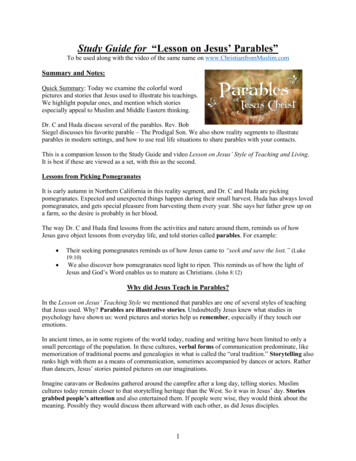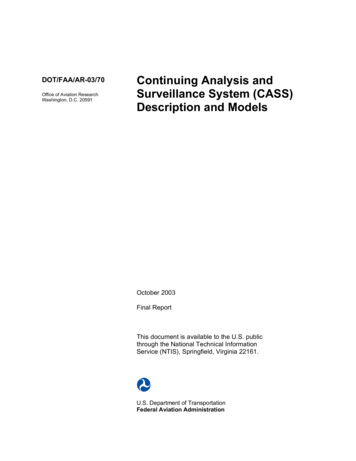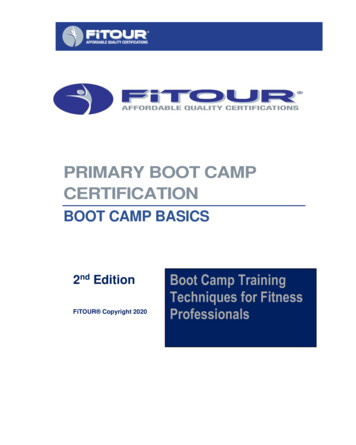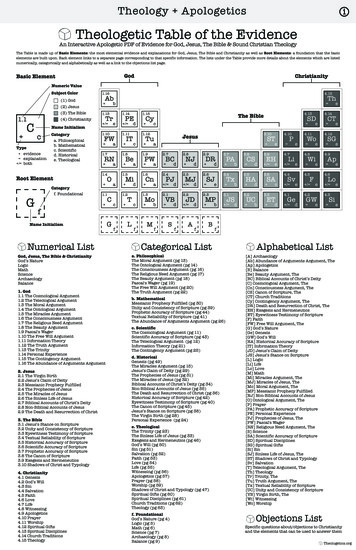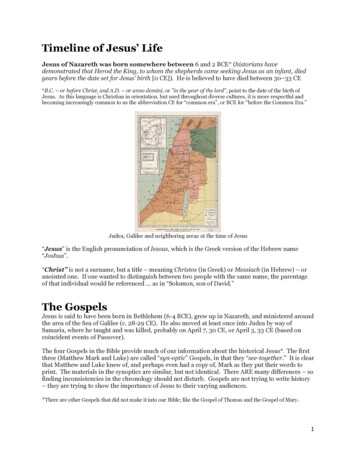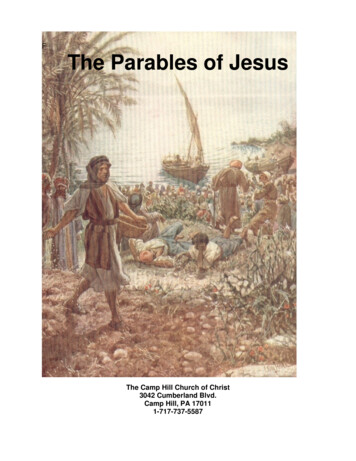
Transcription
FThe Parables of JesusThe Camp Hill Church of Christ3042 Cumberland Blvd.Camp Hill, PA 170111-717-737-5587
IntroductionThe parables of Jesus are among the most beloved of all stories in the Bible, or ever told.Unique in approach, these simple and colorful stories were effective, because they played to theeveryday experiences of people, with poignant endings that brought the message homepowerfully.Jesus' parables were often surprising and paradoxical. Someone once said that listening toJesus tell a parable must have been a little like watching someone throw a ball into the air.Instead of reaching its apex and returning directly to earth, this particular ball starts back downand then veers off at a right angle. We watch astonished, and search for answers.Today, a detailed study of the parables can benefit us as well, as we search for our ownanswers.It is my intention to organize the material into a traditional 13 week format. However, there ismuch more than can be covered in this time period. There are over 40 parables and parabolicsayings covered in this outline, and that is not exhaustive. I encourage students of the Gospelto study the parables in depth on their own time. This is simply a study tool – let God’s word beyour guide.AcknowledgementsI wish to thank Brother Paul Cantrell for suggesting the approach for categorizing the parables,and for encouraging me to compile this study guide.Many thoughts were gleaned from “The Parables – Understanding the Stories Jesus Told” bySimon J. Kistemaker. As much of the material is from this source, I have not made specificreferences. Please consider this book as “referenced” for much of this study. As with anysource other than the Bible, I urge caution, as I disagree with the author on some points. Othersources were used as well, sometimes verbatim – this work is as much a compilation of materialfrom several sources, for the purpose of my own studies and teaching – as such, I do notconsider this an original work.Cover Image – “Feeding the Multitude” by William Hole. From The Life of Jesus of Nazareth.Eighty Pictures. Public domain - copyright expired.All images used are believed to be public domain.Compiled by Brian L. Dowlerbdowler@gmail.com2
Table of Contents1) Introduction to the Parables. 5Types of Parables. 5The Composition of the Parables. 6The Purpose of the Parables. 6Interpretation of the Parables . 62) The Great Value of the Kingdom . 9Parable of the Hidden Treasure (Matt 13:44) . 9Parable of the Pearl of Great Price (Matt 13:45-46) . 9Parable of the Great Feast (Luke 14:15-24). 11Parable of the Wedding Feast (Matt 22:1-14). 133) The Cost of Citizenship of the Kingdom (1) . 16Parable of the Lost Sheep (Luke 15:1-7; Matt 18:12-14) . 16Parable of the Lost Coin (Luke 15:8-10) . 17Parable of the Prodigal Son (Luke 15:11-32) . 194) The Cost of Citizenship in the Kingdom (2) . 23Parable of the Seed Growing Secretly (Mark 4:26-29) . 23Parable of a Tower Builder and King Going Forth to Battle (Luke 14:28-33). 24Parable of a Rich Fool (Luke 12:13-21) . 26Parable of the Empty House (Luke 11:24-26; Matt 12:43-45) . 285) Growth and Effectiveness of the Kingdom . 31Parable of the Mustard Seed (Matt 13:31; Mark 4:30-32; Luke 13:18-19). 31Parable of the Yeast (Matt 13:33; Luke 13:20-21) . 33Parable of the Strong One Defeated (Luke 11:21-23; Matt 12:29) . 34Parable of the Barren Fruit Tree (Luke 13:6-9) . 366) Ungodliness in the Kingdom . 38Parable of the Weeds (Matt 13:24-30, 36-43) . 38Parable of the Drag-Net (Matt 13:47-50). 40Parable of the Talents (Matt 25:14-30). 42Parable of the Pounds (Luke 19:11-27) . 457) Duties in the Kingdom (1) . 49Parable of the Householder (Matt 13:52). 49Parable of the Soils (Sower) (Matt 13:1-9, 18-23; Mark 4:1-9, 13-20; Luke 8:4-8, 11-15). 50Parable of the Great Feast (Luke 14:7-14). 53Parable of the Barren Fig Tree (Luke 13:6-9) . 568) Duties in the Kingdom (2) . 59Parable of the Pharisee and the Tax Collector (Luke 18:9-14). 59Parable of the Two Sons (Matt 21:28-32). 62Parable of the Tenants (Matt 21:33-45) . 63Parable of the Rich Fool (Luke 12:16-21) . 669) Duties in the Kingdom (3) . 70Parable of the Unmerciful Servant (Matt 18:23-45) . 70Parable of the Friend at Midnight (Luke 11:5-8). 73Parable of the Widow and the Judge (Luke 18:1-8) . 7510) Duties in the Kingdom (4) . 783
Parable of the Good Samaritan (Luke 10:30-37). 78Parable of the Laborers in the Vineyard (Matt 20:1-16). 82Parable of the Unfaithful Steward (Luke 16:1-12) . 8611) The Need to be Ready for the Return of the King (1) . 90Parable of the Household Servants (Luke 12:35-40; Mark 13:32-37). 90Parable of the Servant with Authority (Matt 24:45-51; Luke 12:41-48) . 92Parable of the Master of the House (Matt 24:45-51; Luke 12:41-46) . 9412) The Need to be Ready for the Return of the King (2) . 96Parable of the Ten Virgins (Matt 15:1-13) . 96Parable of the Sheep and Goats (Matt 25:31-46). 100Parable of the Rich Man and Lazarus (Luke 16:19-31). 10313) Other Parables and Parabolic Sayings . 107Salt and Light (Matt 5:13-16; Mark 9:50; Luke 14:34-35) . 107Two Builders (Matt 7:24-27; Luke 6:47-48) . 110Children in the Marketplace (Matt 11:16-19; Luke 7:31-35) . 112Parable of the Burglar (Matt 24:42-44; Luke 12:39-40). 114Parable of the Farmer and Servant (Luke 17:7-10) . 116Points to Ponder . 1184
1) Introduction to the ParablesIn his parables, Jesus drew interesting verbal word pictures of the world around his listeners.These colorful stories, taken from everyday life, were used to teach simple yet powerful lessons.In his parables, the emphasis is usually placed at the end of the story – making a strongconclusion that led the listener to accept the message. The messages were so plain, and sosimple, that only the most hardened could refuse or reject the teaching.In The Parables of the Kingdom C. H. Dodd wrote that a parable "leaves the mind in sufficientdoubt about its precise application to tease it into active thought." Parables often have more incommon with probing, uncompromising, puzzling questions than they do with answers.There is some disagreement on the exact number of stories to be characterized as parables. Ofthe four canonical gospels the parables are almost all in the three synoptic gospels. Accordingto one count, The Gospel of Luke contains both the largest total number of parables (24) and thelargest number of unique parables found nowhere else (10); The Gospel of Matthew contains 23 parables of which six are unique; The Gospel of Mark contains eight parables of which only one (the Parable of theGrowing Seed, Mark 4:26-29) is unique.John does not contain any parables; rather it contains metaphoric stories or allegories, such asThe Shepherd (John 10:1-21) and The Vine (John 15:1-17) which some scholars argue is aparable, to much disagreement.Although Jesus was not the first teacher to use parables, the number of parables and the impactof his parabolic teachings was without precedent. A famous and quite ancient Old Testamentexample is the parable of the ewe lamb which the prophet Nathan addressed to David. After theking had arranged the death of Bathsheba's husband on the battlefield so that he might himselfmarry Bathsheba, Nathan told him a story about a man who killed another man’s ewe in (2 Sam12:1-4) When David condemned the man as deserving to die, Nathan revealed that the storywas a parable, saying, "You are the man" (v.7).Types of Parables1) True Parables – Stories based on true, visible scenes and events. For example, seedsgrowing, yeast at work, losing a coin. “Self evident truths”.2) Story Parables – Do not rely on obvious “truths” but instead are based upon“experiences”. For example, the Parable of the tares, the rich man and Lazarus, etc.3) Illustrations – Exhibit behaviors to be copied or avoided. For example, the Rich Fool, theGood Samaritan.4) Parabolic Sayings – Short statements, such as; Jesus teachings on Salt and Light,“Physician heal thyself”, “No one sews a new patch on an old garment”, “No one putsnew wine in an old wineskin”, “A pupil is not above his teacher” and “Can a blind manlead a blind man?” Many of these can be found in Luke chapters 4-7.Many parables show traits of two of the above characteristics – not all can be neatly boxed intoone category.5
According to Wikipedia.com, “A parable is a brief, succinct story, in prose or verse thatillustrates a moral or religious lesson. It differs from a fable in that fables use animals, plants,inanimate objects, and forces of nature as characters, while parables generally feature humancharacters A parable is one of the simplest of narratives. It sketches a setting, describes anaction, and shows the results. It often involves a character facing a moral dilemma, or making aquestionable decision and then suffering the consequences. As with a fable, a parable generallyrelates a single, simple, consistent action, without extraneous detail or distractingcircumstances.”The Composition of the Parables Most parables should be interpreted as teaching a single, simple lesson. Many scholarsmake the mistake of trying to “read too much” into the parables. This usually leads to“stretching” the teaching such that it conveys more than what Jesus intended. This typeof interpretation reached it’s apex in the Middle Ages. But today most modern scholarsagree that a master teacher such as Jesus knows that a singe point, taught clearly, isbetter than many points forgotten.There are some parables, however, that teach multiple lessons by design – such as theparable of the sower, which teaches about four different ways that the Word of God isreceived.Jesus often uses the literary device of Triads – three primary characters or mainillustrative keys. For example:o The Friend at Midnight – The traveler, the friend, the neighboro The Prodigal Son – The father, the son, the brothero The Parable of the Virgins – The bridegroom, the wise virgins, the foolish virginsIn Jesus parables, the end is nearly always more important than the beginning. Jesususes “end stress” to make a clear point. This is a deliberate design on his part. It leavesthe user with an impact requiring time to be absorbed and assimilated.o The good Samaritan is introduces last, not firsto The man with only one talent is discussed later than the other twoMany times parables are used to teach new lessons.The Purpose of the ParablesThe parables show that Jesus was acquainted with human life in multiple ways and means. Hewas familiar with and comfortable describing people of all walks of life, from the uneducatedpoor to religious scholars and the rich. Some spoke of the common people – farmers, fishermen, builders Other spoke of managers of estates, finance ministers and judges Jesus also spoke of Pharisees and tax collectors and the richJesus spoke in the language of the people – he taught at their level. Listeners of anybackground or educational level could understand the messages of the parables. Jesus taughtthis way to convey the message of salvation and the kingdom in a clear and simple manner.Interpretation of the ParablesMark 4:11-12 (NIV) He told them, "The secret of the kingdom of God has been given to you. Butto those on the outside everything is said in parables so that, 'they may be ever seeing but6
never perceiving, and ever hearing but never understanding; otherwise they might turn and beforgiven!'Many have read this passage and assumed that the parables are a sort of riddle, understoodonly by those who were “on the inside” or who had been given other teaching as a precursor.They assume that Jesus was hiding his message, not wanting it to be fully revealed at the timeit was taught.But we must interpret this passage in the context in which it is placed. In Mark 3 Jesus encounters blatant unbelief and direct opposition. He is even accused ofbeing possessed by Beelzebub (see Mark 3:22) In Mark 3:6 there are those plotting how they might kill Jesus At the end of Mark 3, Jesus presents his “family” – those who believe. Thus, it is a matter of faith and unbelief. Those who put their faith in Jesus heard theparables and accepted the messages. But others were so hardened that even thesesimple teachings were rejected and misunderstood.There are basic rules of interpretation that should be applied to the parables: Study the historical setting, the religious groups and teachings of the time, the social andpolitical environment, and even geography of the Bible lands, for a fuller understanding Pay close attention to the introductions and the conclusions Check all interpretations against the other teachings of Jesus and the scriptures – forunity and harmony. Translate the meaning to be applied to your life and time today – how can you learn fromand apply the teachings in your own life?Do your best toassociate the parables ofMatthew 13 with thediagram shown here.Do you believe theparables were presentedin their specific orderfor a purpose?7
Points to PonderExamine Luke chapters 4-7. How many “parabolic sayings” can you find?How many other Old Testament parables can you think of?2 Sam 14:1-23;1 Kings 20:35-43;Isa 5:1-7;Isa 28:21-29;Ezek 17:1-24;Ezek 19:1-14;Ezek 20:45-49;Ezek 24:1-14What is your favorite parable, and why?What differences do you see between the Old Testament parables and those of Jesus?8
2) The Great Value of the KingdomParable of the Hidden Treasure (Matt 13:44)Parable of the Pearl of Great Price (Matt 13:45-46)Matthew chapter 13 contains no less than seven parables. The order in which these are toldappears to be deliberate:1. Parable of the Sower – Describes the growth of the kingdom and how men will react to it2. Parable of the Weeds – Warning of difficulties to be faced in growing the Kingdom3. Parable of the Mustard Seed – Great growth of the Kingdom4. Parable of the Yeast – Great growth of the Kingdom5. Parable of the Hidden Treasure – Great value of the Kingdom6. Parable of the Pearl – Great value of the Kingdom7. Parable of the Net – Reward to those in the Kingdom, and punishment to those whooppose itThese are short parables – only two sentences The introduction is the familiar, “The kingdom of heaven is like ” The main point of the parables is found in the second sentence.The parables of the hidden treasure and of the pearl are found only in Matthew. They form atightly-knit pair. They should be examined and discussed together.The concept of hidden or buried treasure is a common theme throughout history. A buried or hidden treasure is an important part of the popular beliefs surroundingpirates. According to popular conception, pirates often buried their stolen fortunes inremote places, intending to return for them later. Popular movies such as the series based on Indiana Jones, the “National Treasure”movies, and the Pirates of the Caribbean series were built on these ideas. The “Mindenhall Treasure” is one of the most important collections of silver tableware ofthe late Roman Empire. The silver which was found in Mildenhall, Suffolk in 1942 whena farmer who was making his fields ready for planting struck it with his plow. In Biblical times, the banking system was not well established, and houses were easilybroken into – so “burying one’s treasure” in their yard or a field may have been acommon occurrence among everyday people. But if the owner died, the treasure would remain hidden, unless found by someone else.Imagine a hired hand, plowing a field behind an ox or a mule. The blade hits something hard.Thinking it is a rock, the man starts to dig it up to cast it to the side. But, to his surprise, he findsa great treasure. The man could not just take the treasure – as people would ask him where he cameupon such good fortune. If he did not own the field, it would be obvious that it belongedto the land owner. We lack the full details of laws of ownership in such cases, in Jesus day. Therefore, weare not supposed to debate the morality of buying the field when one knows of thetreasure hidden in it. Jesus assumes this is moral and does not call it into question.9
So the man covers the treasure up, and goes home immediately. He sold all that he had and bought the field He knew that the price he would get for the treasure greatly outweighed the value of hishome – he would be greatly rewarded for the investment Imagine the amazement of those who ridiculed him, when they discovered his wisdomafter he bought the field.The parable of the pearl is very similar: In this case, a merchant finds a great pearl The pearl is not hidden, but plain to see He also must leverage all he has to buy the pearl He knows the price for the pearl is a bargainIn Old Testament times, pearls were not widely known or discussed. But by the first centurypearls had become a status symbol among wealthy people. “Do not give dogs what is sacred; do not throw your pearls to pigs. If you do, they maytrample them under their feet, and then turn and tear you to pieces.” Matt 7:6 “I also want women to dress modestly, with decency and propriety, not with braided hairor gold or pearls or expensive clothes” – I Tim 2:9 "The merchants of the earth will weep and mourn over her because no one buys theircargoes any more— cargoes of gold, silver, precious stones and pearls ” Rev 18:11-12In New Testament times, pearl traders would travel far to buy and sell pearls. Inferior onescame from the Red Sea; better pearls were usually from the Persian Gulf or even India. Thepearl trader is not out looking for this great or perfect pearl; he is going about his normal dailybusiness of buying and trading normal pearls. In fact, we get the impression he is surprised tofind such a perfect specimen.Parallels In both parables, the treasure is found by accident The men must make a “now or never” decision Both must give up all they have to obtain the treasureThe intent of these parables is to convey that some rewards are great enough to be worth greatsacrifices: the men may have to sell all that they had, but when they buy the field or the pearl,they gain the treasure, which is worth more than all that he sold.Jesus told this parable to express the idea that even if living according to God's commandmentswas a difficult thing to do and demanded great sacrifices; they would result in the reward of theKingdom of Heaven.Most scholars identify the treasure and the pearl with Christ. We then are like the two men, who“find Christ” and realize that living in Him is worth any sacrifice we can make. Our heavenlyreward is much greater than the sum of all we have on this earth. When we find Christ, we arefilled with joy, and nothing can stop us from giving up our lifestyles, and in some cases even ourcareers or families to claim our reward.The response to Jesus is total surrender. Our salvation is not purchased – it is a gift. Yet Jesusdemands the believer’s heart.10
Points to PonderAn alternate interpretation given by some is that Jesus is the man who buys the field, paying forit with His blood to attain the hidden treasure, i.e. the Church. Some have found it difficult toplace ourselves in the role as the 'man' in this parable since several scripture verses teach thatthe kingdom of heaven cannot be purchased. It is Jesus who, according to the scriptures,purchases His church. In supporting of this interpretation, they cite other scriptures; 1Corinthians 6:20 says "you were bought with a price " 1 Cor 7:23 says "you were bought with aprice." (2 Peter 2:1, 1 Peter 1:18) What do you think?There is a difference between a purchase and a sacrifice. Some have said that these two mendid not make a sacrifice, even though they sold all they had. A sacrifice is giving which expectsno reward. A purchase is giving in return for something else. What do you think? Do you everconsider Christianity a sacrifice?The two men did not speculate – they were not making a risky purchase. They knew, and hadfull assurance, of the value of their treasures. To bypass them would be foolish. Is there anyspeculation n our part in giving up our worldly lives to follow Christ?If Jesus demands our hearts – what does that then imply?"It's no good, it's no good!" says the buyer; then off he goes and boasts about his purchase.”Prov 20:14Parable of the Great Feast (Luke 14:15-24)Jesus is having dinner in the home of a prominent Pharisee. After the worship on the Sabbath,it was common for the speakers and important guests to be invited to eat in the home of aprominent synagogue member. All eyes are one Jesus, “everyone was carefully watching” him to see how he would actand what he would do. It appears Jesus was “set up” – a sick man with dropsy (swellingof the legs and extremities) was placed in front of him. It is contrary to all laws of hospitality to seek advantage against one that you invited tobe your guest. Jesus knew the situation, yet he went anyway, as he was not intimidated– they were no match for Jesus, “The Master”. First he asks the Pharisees and teachers of the law, “Is it right to heal on the Sabbath?”They do not answer him. Why not?o If they say “yes” they condone what he is about to do – which they condemn.o If they say “no” then they will lose favor with the people, and risk Jesus trappingthem in their false logic.o It is easier to sit back and condemn, than to do good. He then heals the man. Jesus defends his healing work by saying, “If your son or ox falls into a well, wouldn'tyou pull him out right away, even on the Sabbath?"o There was nothing they could say.11
The atmosphere in the house is now tense. Not only were the guests watching how Jesuswould handle the setup, many were likely upset over the actions of the other guests, and eventhe host. In this situation, with all watching him closely, Jesus tells a parable. This parable was based upon the behavior of some of the guests, which Jesus hadobserved as he sat for the meal. Many of the guests had tried to take the best seats. This must have caused difficulties for the host. Pride was blocking out humility. A spirit of selfishness and conceit was evident to allthose at the meal.In the parable, Jesus discusses proper behavior at a wedding feast. When you are invited to a wedding feast, don't sit in the best place. Someone moreimportant may have been invited. Then the one who invited you will come and say, "Give your place to this other guest!"o You will be embarrassed and will have to sit in the worst place. When you are invited to be a guest, go and sit in the worst place.o Then the one who invited you may come and say, "My friend, take a better seat!"o You will then be honored in front of all the other guests.Social Etiquette of the Day Tables at a wedding were arranged in a horseshoe shape, with activities in the center The main guest sat at the center of the middle table, 3 people per table. The second most important guest was on his left. (Today we associate the right side or“hand” as most important. But in battle, your left side is weakest – and that is where youwant your best fighting man ) The third most important was on his right. The table to the left received the next three most important guests, with the center seatagain being the most important. Then the table to the right was seated, and the pattern repeated. Normally the host would seat the guests – otherwise chaos could erupt.Lessons of the Parable If you put yourself above others, you will be put down. If you humble yourself, you will be honored. This is the best approach.We are not told what Jesus did as he entered the house of the Pharisee. But we can assumehe would have acted as he taught others to do here. He surely stayed back until the hostseated him at the main table. Perhaps prominent Pharisees had even mocked him for notrushing to the important seats.The Pharisees were no doubt familiar with the proverb of Solomon, in Prov 25:6-7. Yet theyignored this principle.This parable is found only in Luke – but there are many examples of this teaching and examplein the Bible. What ones can you think of? Matt 18:4 – We are to be as children Matt 23:11-12 – We are to humble ourselves John 13:4-17 – Jesus washes the feet of his disciples Rom 12:15 – Ask God to bless those who mistreat you12
Phil 2:3-4 – Consider others more important than yourselvesI Peter 5:6 – Be humble in the presence of GodLev 19:18, Lev 19:34 – O.T. Basis for the “Golden Rule”Matt 7:12, Luke 6:31 – “Golden Rule”Jesus then instructs his host on who he should invite to a banquet meal: Not friends, family, relatives or neighbors Invite the poor, the crippled, the lame, and the blindThe reason? They cannot pay you back – but God will bless and reward you when his peoplerise from death. See Matt 25:40We are not to give on a reciprocal basis, but humbly. Matt 5:43-48 (love your enemies) Matt 6:1-2 (give secretly) James 4:6 (God opposes the proud)Phil 2:8 (Jesus humbled himself)Points to PonderWhat do the actions of the guests, in how they attempted to be seated for the meal, tell youabout them?The prideful behavior of the Pharisees is discussed in many places, such as in Matt 23:5-7. Arethere any behaviors like this that you see in the church today?Is it appropriate in a religious service to use titles such as “Doctor” or “Congressman” whenintroducing or addressing a member of the church?What titles and actions can be used to unscripturally elevate some men over others? (Matt23:9)Jesus did not sit back – he pointed out bad behavior when he saw it. Read Psalms 39:1-2.When should we speak up, and when should we be silent?Read Prov. 22:16. Why do so many people live opposite to this entreaty?Parable of the Wedding Feast (Matt 22:1-14)This is two parables in one – Jesus tells “a story with
to study the parables in depth on their own time. This is simply a study tool – let God’s word be your guide. Acknowledgements I wish to thank Brother Paul Cantrell for suggesting the approach for categorizing the parables, and for encouraging me to compile this study guide.
